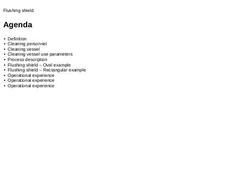
|
|

|
|

|
Congratulations! You have successfully finished this module. Next you will have the opportunity to review the newly acquired knowledge with an interactive questionnaire. You can of course still navigate back to any point in the modules if you wish to review a specific point or subject. Stay curious! |
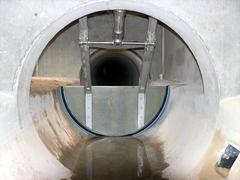
|
In addition to an introductory overview of the various flushing methods and the criteria that must be taken into account when selecting these measures. This module focuses thematically on the physical properties of shafts and the different designs of flushing methods. After completing this module, you will have a sound knowledge of: - process sequences in surge flushing;
- influences on the efficiency of bed-load and suspension waves;
- differentiation of surge flushing devices according to their constructive design or technical equipment;
- process sequences in back-up flushing and their application limits.
|

|
Cleaning of large profile sewers is subject to specific requirements based on the nominal size, pipe material and deposit situation. Their cleaning involves a great deal of time and effort. (Image: Cleaning of large profiles - Deposits) (Image: Cleaning of large profile sewers) |
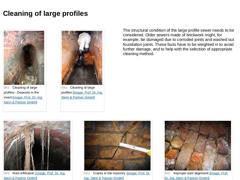
|
(Image: Cleaning of large profiles - Deposits in the invert) (Image: Cleaning of large profiles) The structural condition of the large profile sewer needs to be considered. Older sewers made of brickwork might, for example, be damaged due to corroded joints and washed out foundation joints. These facts have to be weighted in to avoid further damage, and to help with the selection of appropriate cleaning method. (Image: Root infiltration) |
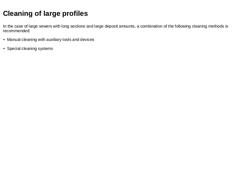
|
In the case of large sewers with long sections and large deposit amounts, a combination of the following cleaning methods is recommended: |
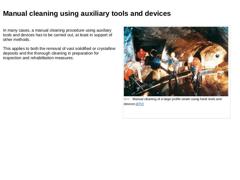
|
In many cases, a manual cleaning procedure using auxiliary tools and devices has to be carried out, at least in support of other methods. This applies to both the removal of vast solidified or crystalline deposits and the thorough cleaning in preparation for inspection and rehabilitation measures. (Image: Manual cleaning of a large profile sewer using hand tools and devices) |
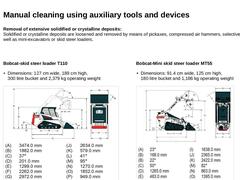
|
Removal of extensive solidified or crystalline deposits:
Solidified or crystalline deposits are loosened and removed by means of pickaxes, compressed air hammers, selective blasting as well as mini-excavators or skid steer loaders. Bobcat-skid steer loader T110 -
Dimensions: 127 cm wide, 189 cm high,
300 litre bucket and 2,379 kg operating weight
(Image: Bobcat-skid steer loader T110) Bobcat-Mini skid steer loader MT55 -
Dimensions: 91.4 cm wide, 125 …
|
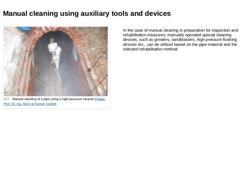
|
(Image: Manual cleaning of a pipe using a high-pressure cleaner) In the case of manual cleaning in preparation for inspection and rehabilitation measures, manually operated special cleaning devices, such as grinders, sandblasters, high pressure flushing devices etc., can be utilised based on the pipe material and the selected rehabilitation method. |
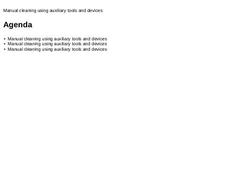
|
|
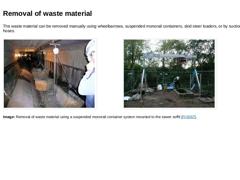
|
The waste material can be removed manually using wheelbarrows, suspended monorail containers, skid steer loaders, or by suction hoses. (Image: Suspended track and containers system) (Image: Removal of the waste container using a gantry crane) Image: Removal of waste material using a suspended monorail container system mounted to the sewer soffit [FI-IDST]. |
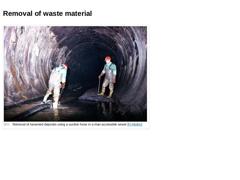
|
(Image: Removal of loosened deposits using a suction hose in a man-accessible sewer) |
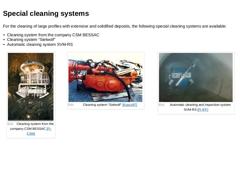
|
For the cleaning of large profiles with extensive and solidified deposits, the following special cleaning systems are available: -
Cleaning system from the company CSM BESSAC
-
Cleaning system “Sielwolf”
-
Automatic cleaning system SVM-RS
|
(Image: Cleaning system from the company CSM BESSAC) |
(Image: Cleaning system “Sielwolf”) |
(Image: Automatic cleaning and inspection system SVM-RS) |
|
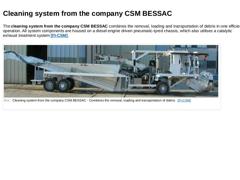
|
The cleaning system from the company CSM BESSAC combines the removal, loading and transportation of debris in one efficient operation. All system components are housed on a diesel engine driven pneumatic-tyred chassis, which also utilises a catalytic exhaust treatment system [FI-CSM]. (Image: Cleaning system from the company CSM BESSAC) |
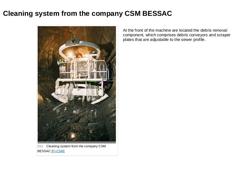
|
(Image: Cleaning system from the company CSM BESSAC) At the front of the machine are located the debris removal component, which comprises debris conveyors and scraper plates that are adjustable to the sewer profile. |
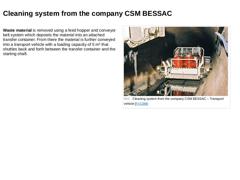
|
Waste material is removed using a feed hopper and conveyor belt system which deposits the material into an attached transfer container. From there the material is further conveyed into a transport vehicle with a loading capacity of 5 m³ that shuttles back and forth between the transfer container and the starting shaft. (Image: Cleaning system from the company CSM BESSAC – Transport vehicle) |
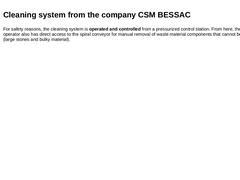
|
For safety reasons, the cleaning system is operated and controlled from a pressurized control station. From here, the machine operator also has direct access to the spiral conveyor for manual removal of waste material components that cannot be transported (large stones and bulky material). |
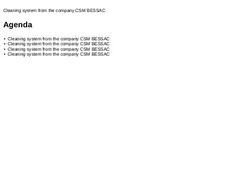
|
|
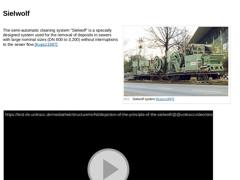
|
The semi-automatic cleaning system “Sielwolf” is a specially designed system used for the removal of deposits in sewers with large nominal sizes (DN 800 to 3,200) without interruptions to the sewer flow [Kupcz1987]. (Video: Depiction of the principle of the "Sielwolf") Video: Operational process of the "Sielwolf" [Image: visaplan GmbH]. This interactive object is only visible online. |

|
According to the manufacturers specifications, the Sielwolf system is able to loosen and remove deposits up to a height of 1.2 m. |
(Image: Sielwolf - Control station) |
(Image: Sielwolf - Coarse material container and sieve machine) |
(Image: Sielwolf - Hydrocyclone and flushing water tank) |
|
(Image: Cleaning system “Sielwolf”) |
|

|
|
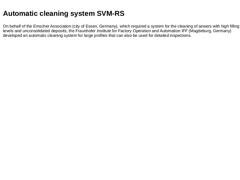
|
On behalf of the Emscher Association (city of Essen, Germany), which required a system for the cleaning of sewers with high filling levels and unconsolidated deposits, the Fraunhofer Institute for Factory Operation and Automation IFF (Magdeburg, Germany) developed an automatic cleaning system for large profiles that can also be used for detailed inspections. |

|
The cleaning and inspection system “SVM-RS” is equipped with a variable four-wheel-drive chassis, which allows for movement and exact positioning along the sewer in partially filled sewers. Owing to the simple adaptation of the chassis, the SVM-RS is very versatile and can be used in sections with nominal sizes of DN 1,600 to DN 2,800 and lengths of up to 1,200 m [Saenz2010] [Saenz2010a]. (Image: Set up scenario of the SVM-RS system with line lengths … |

|
Congratulations! You have successfully finished this module. Next you will have the opportunity to review the newly acquired knowledge with an interactive questionnaire. You can of course still navigate back to any point in the moduls if you wish to review a specific point or subject. Stay curious! |